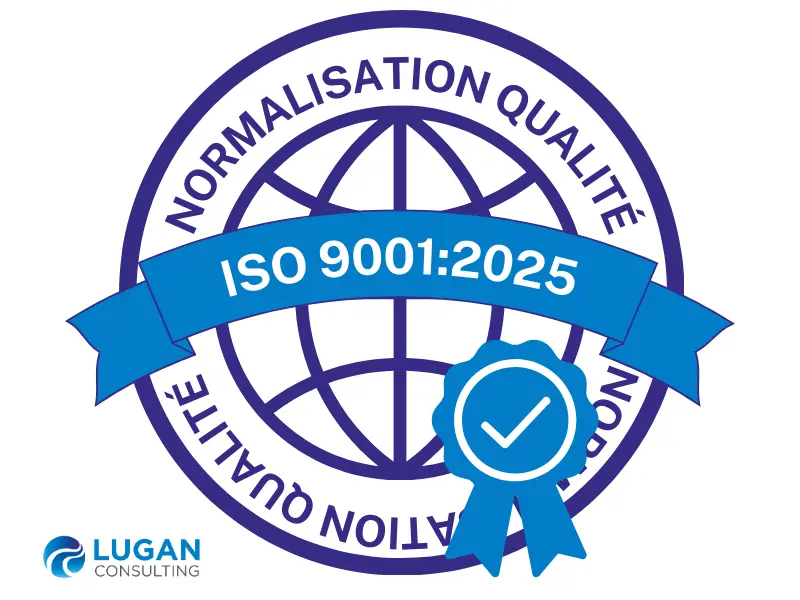Revision of ISO 9001 in 2025: yes... but no, but soon !
ISO 9001 is the cornerstone of the Quality Management System (QMS). It guarantees optimum performance, regulatory compliance and stakeholder satisfaction. It has been evolving in line with changing needs since 1987, with major revisions up to 2015, to keep pace with modern challenges. While a new revision of ISO 9001 was expected by 2025, this has now been pushed back to 2026. This deadline gives companies time to prepare for the advances required to meet the challenges of climate change, digitalisation, technological innovation and quality requirements.
Revision of ISO 9001, Act 1
Since its creation in 1987, the ISO 9001 standard has already undergone 4 revisions, the most important of which took place in 2015. These revisions are necessary to adapt to changes in the economic, social and environmental context. Logically, the next revision should incorporate the challenges posed by climate change and emerging technologies (AI, etc.).
Initial revision work began in December 2023. At this stage, the draft text of the standard, known as the ‘Committee Draft’ (CD), drawn up by the working group, is submitted for consultation to around a hundred national bodies, such as AFNOR in France. These bodies then provide their observations and comments.
The next step is normally to transform the CD into a DIS (Draft for International Standard), with only minor modifications based on the feedback received. However, the volume and nature of the comments received on CD1 led the working group to produce a new version. CD2 was therefore submitted to the national organisations for a second consultation. This unplanned stage in the revision process resulted in an overall delay of several months.
Revision of ISO 9001, Act 2
Also criticised, the CD2 released in May 2024 was rejected mainly because it did not correct the fundamental flaws in ISO 9001:2015 and introduced new, unnecessary or controversial changes:
- Lack of error correction: the draft did not correct existing errors in ISO 9001:2015.
- Commercial orientation: some also accused it of being oriented towards commercial interests rather than the improvement of the standard itself.
- Overly specific content: an appendix booklet, ISO 9001 for Small Businesses, ignored the needs of other types of organization using ISO 9001. This narrow focus was seen as a disadvantage to the wider users of the standard.
- Additional cost: the addition of this booklet would have considerably increased the cost of the ISO 9001 standard, making it more expensive for organisations to acquire.
- Lack of added value: Critics felt that the content of the booklet did not add sufficient value to justify its inclusion in the standard. The information it contained was considered too basic or too specific to be relevant to all users of the standard.

ISO 9001: a change applicable in 2026?
Given all these twists and turns, the validation loop should be completed by the end of 2025. In France, the international public survey enabling users of the standard to provide feedback on this new version will be submitted and will run from January to June 2025. Anyone interested will then be able to find out about the proposed changes and give their opinion.
Theoretically, this phase takes place on the DIS, but the outcry over CD1 and the postponement of the DIS release prompted the teams to submit CD2 for public consultation. Given the urgency of the editorial deadline, it is very likely that the FDIS version will be released directly if CD2 is approved, without the DIS being put out to public enquiry again. The aim is to publish the International Standard (IS) by the end of 2025.
Development points for the future ISO 9001:2026 version
The evolution of the forthcoming version could have a significant impact. Although the specific details are not yet known, the points characterising the direction of the future version have been revealed, notably by AFNOR, which represents France in this international initiative. These include
- Climate change;
- Separating requirements for risks and opportunities;
- The promotion of ethics and integrity;
- The promotion of a quality culture aligned with the company’s missions and values;
- Management review input data: changes in the needs and expectations of relevant interested parties must be taken into account.
ISO 9001:2026 CD 2: Friction points
Among the elements under discussion at international level (some countries approve them and others do not), we find consideration of the following subjects:
- Customer experience;
- The notion of business continuity;
- Emerging technologies.
On this last point, there is no opposition on the subject itself, but it does not seem simple to integrate it into the measurement of the speed of technological change and the diversity of ways in which companies use them. To date, the techno question is approached more from the prism of the working environment: AI, metavers and chatbots are appearing, for example, in employees’ working environments to help them achieve quality.
Given all these twists and turns, the validation loop should be completed by the end of 2025. In France, the international public survey enabling users of the standard to provide feedback on this new version will be submitted and will run from January to June 2025. Anyone interested will then be able to find out about the proposed changes and give their opinion.
Theoretically, this phase takes place on the DIS, but the outcry over CD1 and the postponement of the DIS release prompted the teams to submit CD2 for public consultation. Given the urgency of the editorial deadline, it is very likely that the FDIS version will be released directly if CD2 is approved, without the DIS being put out to public enquiry again. The aim is to publish the International Standard (IS) by the end of 2025.










